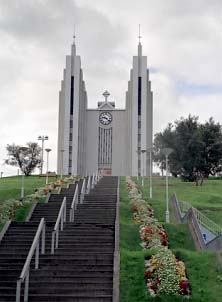| The North |
|
 |
Akureyri is the capital of North-Iceland. With
15,000 inhabitants it is the biggest city after Reykjavik. This doesn't sound
very impressive, but on Iceland, places of 2,000 inhabitants are considered
cities and in fact they appear like it.
At the foot of the Lutherian church lies the shopping centre of the city. Unfortunately we couldn't visit the church, because it was closed due to a funeral service. So, we didn't see the supposedly beautiful stained windows, one of which coming from the cathedral in Coventry. |
| In Akureyri you can also find the most northerly botanical garden. It has a lot of trees (pretty big ones, actually), 400 Icelandic plants and a collection of northern flora. The only thing it didn't have, was a beer-garden (or coffee- or tea-garden). But, the city centre is not far away, so we had coffee there. |
|

|
|
| Who would voluntarily go to a herring museum? Well, when it is the only thing to do within a distance of 100 kilometers (except rafting, which I wouldn't even do when obliged), we do. And we really enjoyed it, as well. | |
 |
Siglufjörğur is the place where you can find it. Apart from the exhibition with everything you might want to know about fishing and selling herring during the centuries, you can have a look in the house where the men and women working in the herring industry lived. It is like you step back into the 1950's, into the lives of these people. You can read the postcards they sent to the people back at home, while drinking a mug of coffee (fresh coffee, not from the 50's). |
 |
|
| Somewhere in the 19th century people starting building with turf. To the left a picture of the church of Víğimıri. The front and the inside are made of wood, and the walls are reinforced with turf, as you can see above. When you consider the shortage of wood and the small trees you can find in Iceland, you can only wonder why they didn't built like this centuries before. |
| Just behind the photographer lies Glaumbær, a farm built with turf. It consists of several small houses next to each other, connected with hallways. It is now a museum, the reason why there are a cart and a sled outside. |
|
 |
In a lot of places you can see wooden frames. Until we came to Sauğárkrókur, we wondered what they were for. Here we found out: to dry fish until it is stockfish. Our guidebook told us that most of the fish is nowadays dried inside, in warmed places. |
| We learned in Ireland that there are forty shades of green. Iceland does not only have 40 shades of green, but also 40 shades of blue. The water of small streams, lakes, fjords and shallow coastlines and the sky has every colour of bluish grey, greenish blue or the brightest turquoise you can imagine. |
|
 |
The national sport is swimming. Every place with more than 100 inhabitants has its own swimming pool, filled with geothermal water. And next to it at least one hot tub, so it is a nice place to go even when the weather isn't that great. It's a real pleasure to soak a while in a hot tub after a couple of hours walking. |
| Mıvatn is a big lake. Its name means mosquito-lake, and it got its name for obvious reasons. Fortunately, most of the mosquitoes are the non-biting sort, so a net over your head takes away the problem (of you don't have a net, they will try to fly into your mouth, nose and ears). The abundance of mosquitoes means there are a lot of birds as well. And because Mıvatn is very shallow and has a lot of small islands, it is also a heaven for all kinds of ducks. |
|
| Dimmuborgir, which translates as
"Dark castles", is a lava-formation
formed when the hot lava was stopped by a big waterbody.
|
|
| There are several walking paths through the rock formations. When you choose the longest one, you comes into an area which resembles dunes. Quite unexpected, but really nice. |